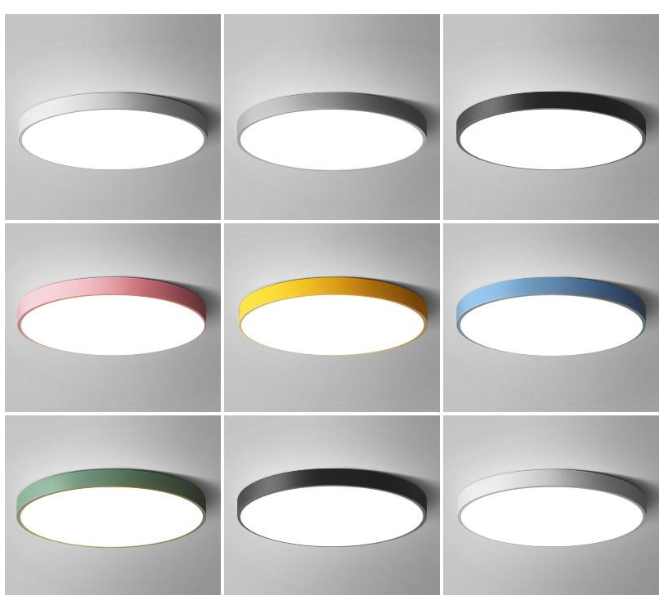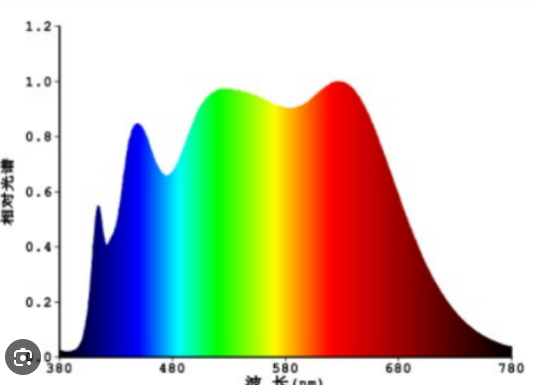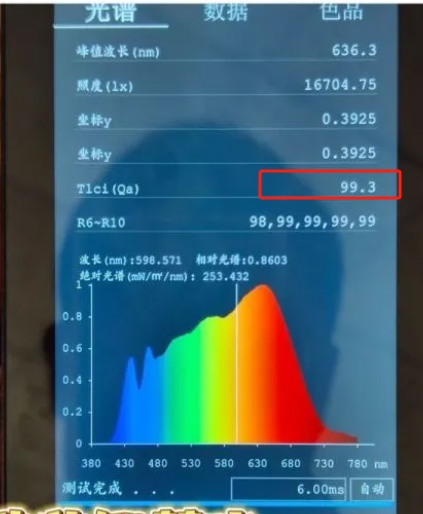When designer Ms. Li recently renovated a children's room for a young family, she immediately replaced the main lighting with full-spectrum ceiling lights. "My child spends a lot of time doing homework and reading under a lamp every day, and traditional LED lights always cause their eyes to get tired easily. This is something my client is particularly concerned about now." Her choice is not an isolated one. On e-commerce platforms, "full-spectrum eye-protection ceiling lights" is a trending search term, with the top 10 best-selling products each exceeding 10,000 units per month. In large home furnishing stores, full-spectrum lighting products from various brands are prominently displayed, and sales consultants invariably emphasize "healthy spectrum" and "close to natural light."

A proactive choice amid health concerns: Our eyes, body, and soul are "craving sunlight."
Modern urban life is imprisoning us in a "siege" of artificial light. Shocking statistics: Urban residents spend an average of over 90% of their time indoors, with teenagers exposed to artificial light for over 10 hours daily. When indoor living becomes the norm, the quality of artificial light directly impacts our health.
"Long-term work and study under spectrally discontinuous or unbalanced light sources can cause visual fatigue, disrupt sleep rhythms, and even indirectly affect mood," said Professor Chen, an ophthalmologist at Peking Union Medical College Hospital. Traditional LED lighting, driven by its pursuit of high brightness and low cost, suffers from significant shortcomings in spectral distribution: excessive concentration of energy in the blue light band, while relatively lacking in crucial wavelengths like red. This unbalanced spectrum is like a single-nutrient diet: while it may fill the stomach, it fails to meet the body's deeper needs for "light nutrition."
Full-spectrum lighting technology aims to address this shortcoming. Its core lies in reproducing the continuous and balanced spectral form of sunlight through specialized phosphor materials and chip design. A recent evaluation report released by the Shanghai Illuminating Engineering Society shows that high-quality full-spectrum LED lamps achieve spectral continuity exceeding 85% of natural light in the visible light band, with a color rendering index (Ra) generally exceeding 95, far exceeding the average of around 80 for ordinary LED lamps. This "technical imitation" of sunlight makes colors appear more realistic and rich, creating a more comfortable and natural visual experience, thereby alleviating eye strain.
Parents have become the most enthusiastic adopters of this "healthy light revolution." In high-end real estate projects in first-tier cities, standard full-spectrum lighting in children's rooms has become a new trend in fine decoration. Ms. Zhang, a parent, expressed a common concern: "Preventing myopia requires more than just reducing electronic device use. Children spend too much time under lights every day. Switching to full-spectrum lighting is the most basic thing we can do to ensure our children's eye health."

Technological Advances and Cost Reductions: Full-spectrum Lighting Enters the Home of the Average Joe
The concept of full-spectrum lighting wasn't born today. Its transition from the laboratory to the mass market hinges on continuous breakthroughs in core technology and the affordable costs brought about by large-scale production.
Early full-spectrum LEDs relied primarily on blue-light chips stimulating special phosphor combinations. Technical barriers and patents drove up prices. The cost of a high-quality full-spectrum LED chip was several times that of a standard LED. However, breakthroughs in violet-light-excited chip technology (such as the blue-light chip + violet-light-excited phosphor solution) by domestic companies like San'an Optoelectronics and HC Semitek have further improved spectral integrity and light efficiency, and mass production capacity has also seen a leap forward.
According to data from the Ministry of Industry and Information Technology (MIIT) through 2023, the annual production capacity growth rate of full-spectrum LED chips in China has exceeded 40% for three consecutive years. This scale effect is directly reflected in the price of end products: three years ago, a full-spectrum ceiling light from a well-known brand typically cost over 1,000 yuan. Today, products with comparable performance have fallen into the mainstream price range of 300-600 yuan. Technological maturity and cost reductions have removed the biggest obstacle to the widespread adoption of full-spectrum technology.
At the same time, full-spectrum technology has cleverly integrated and coexisted with another trend: smart homes. Smart lighting systems place high demands on the dimming and color adjustment capabilities of light sources. Full-spectrum LEDs, with their spectral integrity and adjustability, are naturally an ideal platform for high-end smart lighting. Brands such as Xiaomi, Yeelight, and OPPLE have all made full spectrum a core selling point for their smart ceiling lights. This "full spectrum + intelligence" combination not only meets health needs but also provides a convenient and personalized light environment control experience, further enhancing their market appeal.
Market Education Upgrades and Consumer Awareness Awakens: From "Illumination" to "Eye Protection"
Consumers' perception of lighting environments is undergoing a profound transformation. In the past, "brightness," "energy efficiency," and "aesthetics" were key considerations when choosing lamps. Today, "health," "eye protection," and "comfort" have become key decision-makers. This shift is driven by a multifaceted push for market education.
Social media has become a major battlefield for popularizing knowledge. On platforms like Xiaohongshu and Douyin, topics like "How to Choose an Eye-Protecting Lamp" and "Is Full-Spectrum Lighting a Costly IQ Tax" continue to gain popularity, with related notes and videos accumulating over 100 million views. Professional lighting review bloggers, ophthalmologists, and designers are stepping up to explain professional concepts like spectrum diagrams, the hazards of blue light, and flicker in layman's terms, enhancing consumers' discernment of light quality.
Leading lighting brands have keenly recognized this consumer upgrade and invested heavily in cultivating the full-spectrum lighting concept. NVC Lighting launched the "Bright Guardian Plan," conducting eye-care lectures in schools; while OPPLE Lighting partnered with authoritative organizations to release the "White Paper on Healthy Home Lighting Environments." These initiatives not only promote products but also systematically enhance public awareness of healthy lighting.
The establishment of authoritative standards and certification systems provides a reliable benchmark for consumer choices. The "Healthy Lighting Certification" launched by the China Quality Certification Center (CQC) sets strict thresholds for indicators such as spectral continuity, color rendering index, blue light hazard level, and flicker. Products bearing these certification marks are more likely to gain consumer trust in the market. Standards act as a beacon, providing consumers with a reliable path amidst the clamor of market information.

A sobering reflection behind the prosperity: Only standardized development can ensure steady and long-term success.
Explosive market growth has also been accompanied by a chaotic mix of good and bad. Some vendors exploit consumer information asymmetry to confuse consumers with "pseudo-full-spectrum" products. Some merely flaunt the concept on packaging, while the actual spectrum is no different from that of ordinary LEDs; others create the illusion of "eye protection" by adding ineffective filters; and even worse, they falsify key parameters such as the color rendering index.
"Claims that 'full-spectrum lighting prevents myopia' are inaccurate," stressed Cai Jianqi, Researcher and Director of the Vision Health and Safety Protection Laboratory at the China National Institute of Standardization. "High-quality light sources are an important part of vision protection, but the causes of myopia are complex, requiring comprehensive prevention and control measures based on eye habits and outdoor activities. Consumers should be rational about these claims."
The healthy development of the industry urgently requires improved standards and market regulation. Currently, there are no national mandatory standards for full-spectrum lamps, relying primarily on enterprise and group standards. Accelerating the development and implementation of national standards for full-spectrum lighting products, clarifying key indicator thresholds and testing methods, is a fundamental solution to curbing market chaos and protecting consumer rights. Regulatory authorities should also increase spot checks and crack down on false advertising and parameter falsification to maintain fair competition in the market.
Conclusion:
Full-spectrum ceiling lamps have risen from a niche term in the professional field to a new favorite in the home lighting market. This rise reflects the grand narrative of the nation's awakening health awareness under the Healthy China strategy, a breakthrough in optoelectronics technology, and a vivid reflection of people's pursuit of a refined quality of life amidst the wave of consumption upgrades.
When we actively choose a light that more closely resembles sunlight, we're not only seeking gentler protection for our eyes, but also subconsciously expressing a deep longing for the rhythms of nature. The ultimate purpose of artificial light isn't to replace nature, but rather to preserve a hidden window toward nature for the soul amidst the inevitable "indoor life." This pursuit of "healthy light" will ultimately transcend technical specifications and market hype, pointing to a deeper concern for the essence of life—in a jungle of steel and concrete, how can each beam of light that illuminates our lives hold the gentle power of the rising and setting sun?



